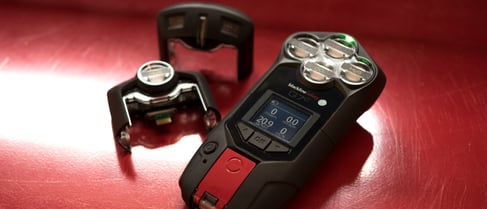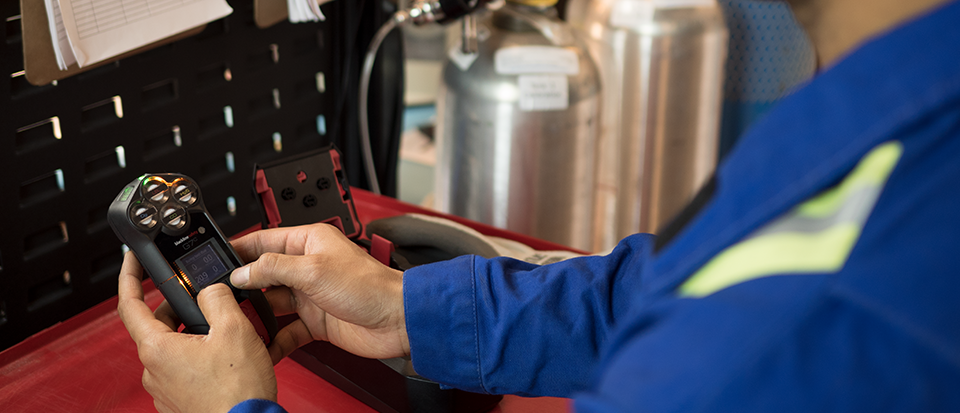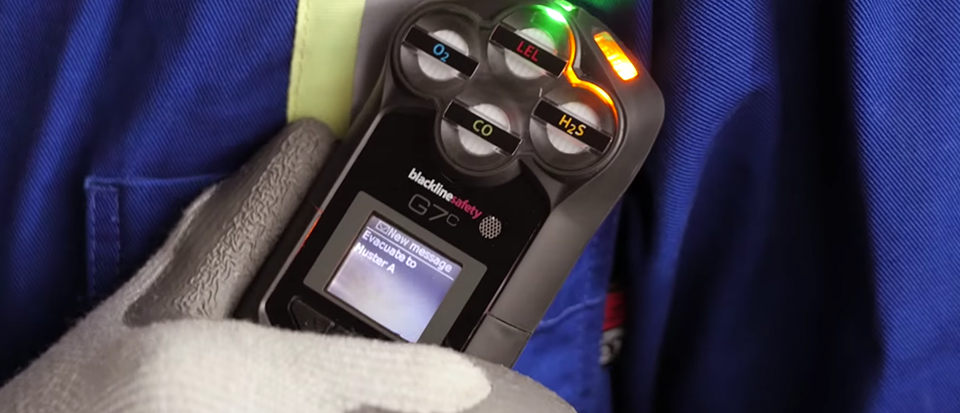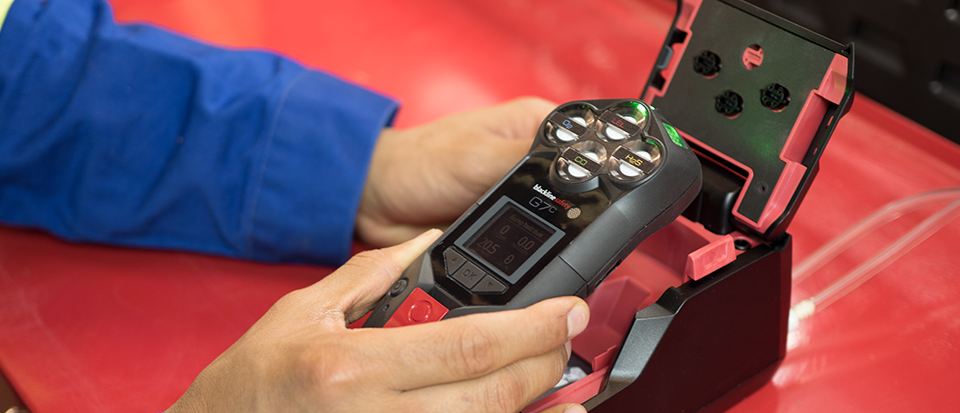Blackline Safety is a technology leader driving innovation in the industrial workforce through IoT (Internet of Things). With connected safety devices and predictive analytics, Blackline enables companies to drive towards zero safety incidents and improved operational performance. Blackline provides wearable devices, personal and area gas monitoring, cloud-connected software and data analytics to meet demanding safety challenges and enhance overall productivity for organizations with coverage in more than 100 countries. Armed with cellular and satellite connectivity, Blackline provides a lifeline to tens of thousands of people, having reported over 200 billion data-points and initiated over seven million emergency alerts. For more information, visit BlacklineSafety.com and connect with us on Facebook, Twitter, LinkedIn and Instagram.
Four Gas Monitor — Gas Detection for Complex Environments
Blackline Safety, Leader in Connected Gas Detection & Lone Worker Safety
April 21, 2017
 When facing unknown environmental hazards invisible to the body’s senses, a gas detector is the first line of defense for worker safety. Portable gas detectors are often part of personal protective equipment (PPE) mandated by businesses and designed to keep personnel safe. Personal four gas monitors or detectors continuously evaluate a worker’s environment for multiple gas hazards. A four gas monitor provides comprehensive gas detection coverage for complex working environments when there is a risk of injury, illness or death from potentially toxic or explosive ambient gases.
When facing unknown environmental hazards invisible to the body’s senses, a gas detector is the first line of defense for worker safety. Portable gas detectors are often part of personal protective equipment (PPE) mandated by businesses and designed to keep personnel safe. Personal four gas monitors or detectors continuously evaluate a worker’s environment for multiple gas hazards. A four gas monitor provides comprehensive gas detection coverage for complex working environments when there is a risk of injury, illness or death from potentially toxic or explosive ambient gases.
Why a four gas monitor versus a single gas detector?
Hazards posed by gases can be classified into three categories: toxic, asphyxiating and combustible. Four gas monitors are typically configured with sensors to address each of these scenarios for a given worksite or scenario. For example, in the energy industry, sour gas presents a significant risk of hydrogen sulfide (H2S) exposure to workers. Many businesses supplement monitoring of H2S with combustible gases, oxygen and carbon monoxide. Combustible gas sensors are a smart addition to locations where natural gas is present with H2S, addressing the detection of a potentially explosive atmosphere. Everyone requires oxygen, which can be displaced by other gases, causing a deficiency. Further, incomplete combustion can generate carbon monoxide, an asphyxiating gas.
G7 is a leading four gas monitor
A four gas monitor is often a smart investment for many industries and applications. Blackline’s G7 connected gas detection system delivers an exclusive customizable, modular design, providing tailored comprehensive gas detection for every work scenario. Quad-gas cartridges turn G7 into a four gas monitor and are compatible with a selection of gas sensors.
G7 with a Quad-gas Cartridge is a highly configurable four gas monitor that is compatible with a range of gas sensors including combustible gases, hydrogen sulfide, carbon monoxide and oxygen. Other sensors are currently under development to expand our line of available sensors.
Let us know about your gas sensor requirements.
Unseen hazards
Oxygen sensors will alert for both oxygen-enriched and depleted environments. Oxygen enrichment (more than 23.5%) occurs when oxygen concentration exceeds that of fresh air, potentially increasing the risk of combustion of flammable gases. Oxygen deficient environments (less than 19.5% oxygen) present a suffocation hazard and can impact the body’s respiratory system in seconds. Other gases, toxic or not, can displace oxygen, creating a hazardous atmosphere that impairs worker respiration.
Combustible gases pose a risk of explosion. LEL sensors detect the concentration of flammable or explosive gases and alert the user if the level of gas surpasses the pre-configured concentration below the lower explosive limit (LEL), well before the potential for explosion occurs.
Toxic gases are often fast acting and, depending on the concentration, can impact systems within the body very quickly or can pose a longer-term health risk. Electrochemical gas sensors, such as for carbon monoxide (CO) and hydrogen sulfide (H2S) alert well before toxic gas levels reach harmful concentrations.
G7 four gas monitor sensors
G7 supports three main gas detection sensor types that accommodate the monitoring of toxic, asphyxiating and combustible gases.

Electrochemical gas sensors
- Hydrogen sulfide, carbon monoxide and oxygen (pumped)
- Monitor Short Term Exposure Limits (STELs) and Time Weighted Averages (TWAs)
Catalytic (pellistor) gas sensors
- Detects combustible gases through controlled oxidation
- Does not work well in an oxygen-depleted environment
- Measures from 0-100% of the LEL
- May not give a reading when above 100% LEL
Infrared (IR) gas sensors
- Detects combustible gases through IR absorption
- Do not require oxygen to accurately function
- Measures 0-100% LEL
Industries well served by a four gas monitor
Hazardous gases vary from industry to industry, based on materials being handled and naturally-occurring environmental conditions. Comprehensive gas detection with a four gas monitor accommodates for diverse gas threats that employees can face in the line of work.

Oil and gas
- Toxic hydrogen sulfide (H2S) gas is present in sour natural gas
- Carbon monoxide (CO), an asphyxiating gas that may be generated from incomplete combustion
- A gas leak can displace oxygen, posing a risk to the worker
- Hydrocarbon gas leaks, such as natural gas, can pose an explosion risk
Water and wastewater
- Methane gas can be generated by biological processes that break down wastes, posing an explosion risk
- Toxic hydrogen sulfide can be generated by biological processes
Mining
- Like water and wastewater facilities, mining operations also pose the risk of methane and H2S exposure. Additionally, carbon monoxide may be present — a toxic gas capable of depleting oxygen levels. In these cases, both LEL and electrochemical sensors are required for comprehensive detection coverage of possible gas exposures.
Construction
- Heaters that operate during cold weather can generate carbon monoxide if propane or natural gas combustion is hindered
G7 devices with a Quad-gas cartridge provide safety monitoring and gas coverage for a variety of complex working environments. The quad-gas cartridge supports up to four gases, but can also be configured for two or three gas sensors.
Maintaining four gas monitors
Proper maintenance and calibration are necessary to ensure reliable four gas monitor performance and accuracy — improper maintenance can lead to inaccurate readings or failure to detect a sensor that is not working.

OSHA recommends developing standardized procedures to ensure calibrations and proper usage, including the documentation and verification of proper maintenance. Calibration refers to measuring an instrument’s accuracy relative to a known traceable concentration of a test gas. It is important to calibrate devices to environmental conditions that are the same or close to real-world work conditions. Further, ISEA recommends verifying the operational capacity of gas detection sensors (bump testing), before each shift, plus regular calibration.
Blackline’s G7 Dock offers a cost-effective solution to perform bump tests and calibrations while minimizing the amount of calibration gas used. We’ll highlight our G7 Dock in an upcoming blog article.
Get In Touch
Let’s start a discussion about your safety challenges and needs.
Related Blog Posts
Real-Life Incident: Mason’s Story — High H2S Exposure
November 25, 2025
“Shortness of breath. Request EMS to the location.” How Real-Time Gas Detection Led to a Quick Save Exposure to toxic gases can go from a strange...
3 Creative Applications of Blackline Safety Technology
July 29, 2025
Designed for Safety. Adapted with Ingenuity. Blackline devices are built for tough jobs—gas detection, lone worker monitoring, real-time emergency...
Real-Life Incident: Superior Fire Department Drug Bust
July 28, 2025
G7 helpsHAZMATteam safely navigate Wisconsin's largest DMT lab When Superior Wisconsin Fire Department received the call, the situation was...


